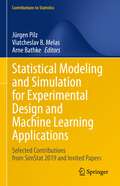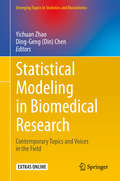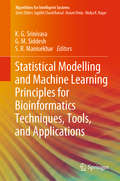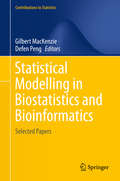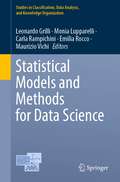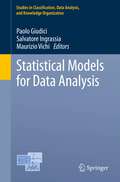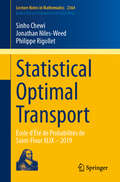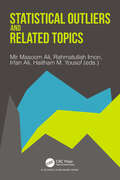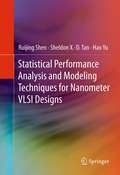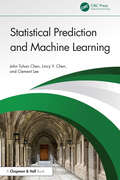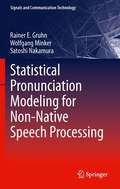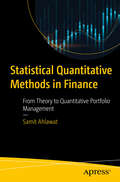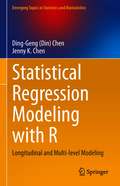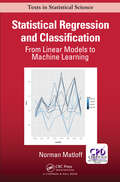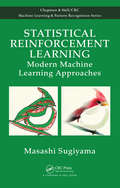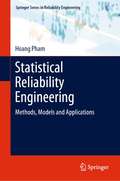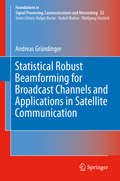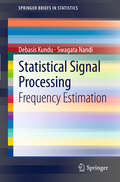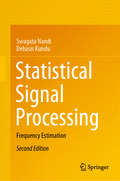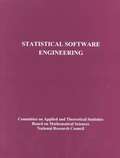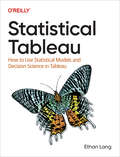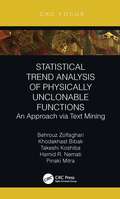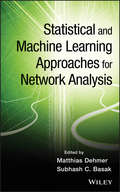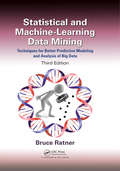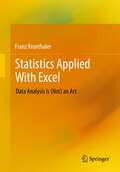- Table View
- List View
Statistical Modeling and Simulation for Experimental Design and Machine Learning Applications: Selected Contributions from SimStat 2019 and Invited Papers (Contributions to Statistics)
by Jürgen Pilz Viatcheslav B. Melas Arne BathkeThis volume presents a selection of articles on statistical modeling and simulation, with a focus on different aspects of statistical estimation and testing problems, the design of experiments, reliability and queueing theory, inventory analysis, and the interplay between statistical inference, machine learning methods and related applications. The refereed contributions originate from the 10th International Workshop on Simulation and Statistics, SimStat 2019, which was held in Salzburg, Austria, September 2–6, 2019, and were either presented at the conference or developed afterwards, relating closely to the topics of the workshop. The book is intended for statisticians and Ph.D. students who seek current developments and applications in the field.
Statistical Modeling in Biomedical Research: Contemporary Topics and Voices in the Field (Emerging Topics in Statistics and Biostatistics)
by Ding-Geng Din Chen Yichuan ZhaoThis edited collection discusses the emerging topics in statistical modeling for biomedical research. Leading experts in the frontiers of biostatistics and biomedical research discuss the statistical procedures, useful methods, and their novel applications in biostatistics research. Interdisciplinary in scope, the volume as a whole reflects the latest advances in statistical modeling in biomedical research, identifies impactful new directions, and seeks to drive the field forward. It also fosters the interaction of scholars in the arena, offering great opportunities to stimulate further collaborations. This book will appeal to industry data scientists and statisticians, researchers, and graduate students in biostatistics and biomedical science. It covers topics in:Next generation sequence data analysisDeep learning, precision medicine, and their applicationsLarge scale data analysis and its applicationsBiomedical research and modelingSurvival analysis with complex data structure and its applications.
Statistical Modelling and Machine Learning Principles for Bioinformatics Techniques, Tools, and Applications (Algorithms for Intelligent Systems)
by K. G. Srinivasa G. M. Siddesh S. R. ManisekharThis book discusses topics related to bioinformatics, statistics, and machine learning, presenting the latest research in various areas of bioinformatics. It also highlights the role of computing and machine learning in knowledge extraction from biological data, and how this knowledge can be applied in fields such as drug design, health supplements, gene therapy, proteomics and agriculture.
Statistical Modelling in Biostatistics and Bioinformatics
by Gilbert Mackenzie Defen PengThis book presents selected papers on statistical model development related mainly to the fields of Biostatistics and Bioinformatics. The coverage of the material falls squarely into the following categories: (a) Survival analysis and multivariate survival analysis, (b) Time series and longitudinal data analysis, (c) Statistical model development and (d) Applied statistical modelling. Innovations in statistical modelling are presented throughout each of the four areas, with some intriguing new ideas on hierarchical generalized non-linear models and on frailty models with structural dispersion, just to mention two examples. The contributors include distinguished international statisticians such as Philip Hougaard, John Hinde, Il Do Ha, Roger Payne and Alessandra Durio, among others, as well as promising newcomers. Some of the contributions have come from researchers working in the BIO-SI research programme on Biostatistics and Bioinformatics, centred on the Universities of Limerick and Galway in Ireland and funded by the Science Foundation Ireland under its Mathematics Initiative.
Statistical Models and Methods for Data Science (Studies in Classification, Data Analysis, and Knowledge Organization)
by Maurizio Vichi Emilia Rocco Leonardo Grilli Monia Lupparelli Carla RampichiniThis book focuses on methods and models in classification and data analysis and presents real-world applications at the interface with data science. Numerous topics are covered, ranging from statistical inference and modelling to clustering and factorial methods, and from directional data analysis to time series analysis and small area estimation. The applications deal with new developments in a variety of fields, including medicine, finance, engineering, marketing, and cyber risk.The contents comprise selected and peer-reviewed contributions presented at the 13th Scientific Meeting of the Classification and Data Analysis Group of the Italian Statistical Society, CLADAG 2021, held (online) in Florence, Italy, on September 9–11, 2021. CLADAG promotes advanced methodological research in multivariate statistics with a special focus on data analysis and classification, and supports the exchange and dissemination of ideas, methodological concepts, numerical methods, algorithms, and computational and applied results at the interface between classification and data science.
Statistical Models for Data Analysis
by Paolo Giudici Maurizio Vichi Salvatore IngrassiaThe papers in this book cover issues related to the development of novel statistical models for the analysis of data. They offer solutions for relevant problems in statistical data analysis and contain the explicit derivation of the proposed models as well as their implementation. The book assembles the selected and refereed proceedings of the biannual conference of the Italian Classification and Data Analysis Group (CLADAG), a section of the Italian Statistical Society.
Statistical Optimal Transport: École d'Été de Probabilités de Saint-Flour XLIX – 2019 (Lecture Notes in Mathematics #2364)
by Sinho Chewi Jonathan Niles-Weed Philippe RigolletThis monograph aims to offer a concise introduction to optimal transport, quickly transitioning to its applications in statistics and machine learning. It is primarily tailored for students and researchers in these fields, yet it remains accessible to a broader audience of applied mathematicians and computer scientists. Each chapter is complemented with exercises for the reader to test their understanding. As such, this monograph is suitable for a graduate course on the topic of statistical optimal transport.
Statistical Outliers and Related Topics
by Mir Masoom Ali Irfan Ali Haitham M. Yousof Rahmatullah ImonThe book is a collection of different aspects of outliers and related topics written by experts. Topics covered include definition of outliers, their sources, consequences, identification, computational and robustness issues, handling of outliers in diversified areas of statistics such as univariate and multivariate data, linear and generalized linear models, time series, linear functional and structural models, circular data, spatial data, big data, high dimensional data, multi-view data. The book emphasizes the importance of outliers, and will appeal to workers in Data Mining; which is one of the fastest-growing business applications of statistics. The book makes outlier detection methods widely usable by practitioners. Examples are drawn from various fields.
Statistical Performance Analysis and Modeling Techniques for Nanometer VLSI Designs
by Hao Yu Ruijing Shen Sheldon X.-D. TanSince process variation and chip performance uncertainties have become more pronounced as technologies scale down into the nanometer regime, accurate and efficient modeling or characterization of variations from the device to the architecture level have become imperative for the successful design of VLSI chips. This book provides readers with tools for variation-aware design methodologies and computer-aided design (CAD) of VLSI systems, in the presence of process variations at the nanometer scale. It presents the latest developments for modeling and analysis, with a focus on statistical interconnect modeling, statistical parasitic extractions, statistical full-chip leakage and dynamic power analysis considering spatial correlations, statistical analysis and modeling for large global interconnects and analog/mixed-signal circuits. Provides readers with timely, systematic and comprehensive treatments of statistical modeling and analysis of VLSI systems with a focus on interconnects, on-chip power grids and clock networks, and analog/mixed-signal circuits;Helps chip designers understand the potential and limitations of their design tools, improving their design productivity;Presents analysis of each algorithm with practical applications in the context of real circuit design;Includes numerical examples for the quantitative analysis and evaluation of algorithms presented. Provides readers with timely, systematic and comprehensive treatments of statistical modeling and analysis of VLSI systems with a focus on interconnects, on-chip power grids and clock networks, and analog/mixed-signal circuits;Helps chip designers understand the potential and limitations of their design tools, improving their design productivity;Presents analysis of each algorithm with practical applications in the context of real circuit design;Includes numerical examples for the quantitative analysis and evaluation of algorithms presented.
Statistical Prediction and Machine Learning
by John Tuhao Chen Clement Lee Lincy Y. ChenWritten by an experienced statistics educator and two data scientists, this book unifies conventional statistical thinking and contemporary machine learning framework into a single overarching umbrella over data science. The book is designed to bridge the knowledge gap between conventional statistics and machine learning. It provides an accessible approach for readers with a basic statistics background to develop a mastery of machine learning. The book starts with elucidating examples in Chapter 1 and fundamentals on refined optimization in Chapter 2, which are followed by common supervised learning methods such as regressions, classification, support vector machines, tree algorithms, and range regressions. After a discussion on unsupervised learning methods, it includes a chapter on unsupervised learning and a chapter on statistical learning with data sequentially or simultaneously from multiple resources.One of the distinct features of this book is the comprehensive coverage of the topics in statistical learning and medical applications. It summarizes the authors’ teaching, research, and consulting experience in which they use data analytics. The illustrating examples and accompanying materials heavily emphasize understanding on data analysis, producing accurate interpretations, and discovering hidden assumptions associated with various methods.Key Features: Unifies conventional model-based framework and contemporary data-driven methods into a single overarching umbrella over data science. Includes real-life medical applications in hypertension, stroke, diabetes, thrombolysis, aspirin efficacy. Integrates statistical theory with machine learning algorithms. Includes potential methodological developments in data science.
Statistical Pronunciation Modeling for Non-Native Speech Processing
by Wolfgang Minker Rainer E. Gruhn Satoshi NakamuraIn this work, the authors present a fully statistical approach to model non--native speakers' pronunciation. Second-language speakers pronounce words in multiple different ways compared to the native speakers. Those deviations, may it be phoneme substitutions, deletions or insertions, can be modelled automatically with the new method presented here. The methods is based on a discrete hidden Markov model as a word pronunciation model, initialized on a standard pronunciation dictionary. The implementation and functionality of the methodology has been proven and verified with a test set of non-native English in the regarding accent. The book is written for researchers with a professional interest in phonetics and automatic speech and speaker recognition.
Statistical Quantitative Methods in Finance: From Theory to Quantitative Portfolio Management
by Samit AhlawatStatistical quantitative methods are vital for financial valuation models and benchmarking machine learning models in finance. This book explores the theoretical foundations of statistical models, from ordinary least squares (OLS) to the generalized method of moments (GMM) used in econometrics. It enriches your understanding through practical examples drawn from applied finance, demonstrating the real-world applications of these concepts. Additionally, the book delves into non-linear methods and Bayesian approaches, which are becoming increasingly popular among practitioners thanks to advancements in computational resources. By mastering these topics, you will be equipped to build foundational models crucial for applied data science, a skill highly sought after by software engineering and asset management firms. The book also offers valuable insights into quantitative portfolio management, showcasing how traditional data science tools can be enhanced with machine learning models. These enhancements are illustrated through real-world examples from finance and econometrics, accompanied by Python code. This practical approach ensures that you can apply what you learn, gaining proficiency in the statsmodels library and becoming adept at designing, implementing, and calibrating your models. By understanding and applying these statistical models, you enhance your data science skills and effectively tackle financial challenges. What You Will Learn Understand the fundamentals of linear regression and its applications in financial data analysis and prediction Apply generalized linear models for handling various types of data distributions and enhancing model flexibility Gain insights into regime switching models to capture different market conditions and improve financial forecasting Benchmark machine learning models against traditional statistical methods to ensure robustness and reliability in financial applications Who This Book Is For Data scientists, machine learning engineers, finance professionals, and software engineers
Statistical Regression Modeling with R: Longitudinal and Multi-level Modeling (Emerging Topics in Statistics and Biostatistics)
by Ding-Geng (Din) Chen Jenny K. ChenThis book provides a concise point of reference for the most commonly used regression methods. It begins with linear and nonlinear regression for normally distributed data, logistic regression for binomially distributed data, and Poisson regression and negative-binomial regression for count data. It then progresses to these regression models that work with longitudinal and multi-level data structures. The volume is designed to guide the transition from classical to more advanced regression modeling, as well as to contribute to the rapid development of statistics and data science. With data and computing programs available to facilitate readers' learning experience, Statistical Regression Modeling promotes the applications of R in linear, nonlinear, longitudinal and multi-level regression. All included datasets, as well as the associated R program in packages nlme and lme4 for multi-level regression, are detailed in Appendix A. This book will be valuable in graduate courses on applied regression, as well as for practitioners and researchers in the fields of data science, statistical analytics, public health, and related fields.
Statistical Regression and Classification: From Linear Models to Machine Learning (Chapman & Hall/CRC Texts in Statistical Science)
by Norman Matloff<p>Statistical Regression and Classification: From Linear Models to Machine Learning takes an innovative look at the traditional statistical regression course, presenting a contemporary treatment in line with today's applications and users. <p>The book treats classical regression methods in an innovative, contemporary manner. Though some statistical learning methods are introduced, the primary methodology used is linear and generalized linear parametric models, covering both the Description and Prediction goals of regression methods. The author is just as interested in Description applications of regression, such as measuring the gender wage gap in Silicon Valley, as in forecasting tomorrow's demand for bike rentals. An entire chapter is devoted to measuring such effects, including discussion of Simpson's Paradox, multiple inference, and causation issues. Similarly, there is an entire chapter of parametric model fit, making use of both residual analysis and assessment via nonparametric analysis.</p>
Statistical Reinforcement Learning: Modern Machine Learning Approaches (Chapman & Hall/CRC Machine Learning & Pattern Recognition)
by Masashi SugiyamaReinforcement learning (RL) is a framework for decision making in unknown environments based on a large amount of data. Several practical RL applications for business intelligence, plant control, and gaming have been successfully explored in recent years. Providing an accessible introduction to the field, this book covers model-based and model-free approaches, policy iteration, and policy search methods. It presents illustrative examples and state-of-the-art results, including dimensionality reduction in RL and risk-sensitive RL. The book provides a bridge between RL and data mining and machine learning research.
Statistical Reliability Engineering: Methods, Models and Applications (Springer Series in Reliability Engineering)
by Hoang PhamThis book presents the state-of-the-art methodology and detailed analytical models and methods used to assess the reliability of complex systems and related applications in statistical reliability engineering. It is a textbook based mainly on the author’s recent research and publications as well as experience of over 30 years in this field. The book covers a wide range of methods and models in reliability, and their applications, including: statistical methods and model selection for machine learning; models for maintenance and software reliability; statistical reliability estimation of complex systems; and statistical reliability analysis of k out of n systems, standby systems and repairable systems. Offering numerous examples and solved problems within each chapter, this comprehensive text provides an introduction to reliability engineering graduate students, a reference for data scientists and reliability engineers, and a thorough guide for researchers and instructors in the field.
Statistical Robust Beamforming for Broadcast Channels and Applications in Satellite Communication (Foundations in Signal Processing, Communications and Networking #22)
by Andreas GründingerThis book investigates adaptive physical-layer beamforming and resource allocation that ensure reliable data transmission in the multi-antenna broadcast channel. The book provides an overview of robust optimization techniques and modelling approximations to deal with stochastic performance metrics. One key contribution of the book is a closed-form description of the achievable rates with unlimited transmit power for a rank-one channel error model. Additionally, the book provides a concise duality framework to transform mean square error (MSE) based beamformer designs, e.g., quality of service and balancing optimizations, into equivalent uplink filter designs. For the algorithmic solution, the book analyses the following paradigm: transmission to receivers with large MSE targets (low demands) is switched off if the transmit power is low. The book also studies chance constrained optimizations for limiting the outage probability. In this context, the book provides two novel conservative outage probability approximations, that result in convex beamformer optimizations. To compensate for the remaining inaccuracy, the book introduces a post-processing power allocation. Finally, the book applies the introduced beamformer designs for SatCom, where interference from neighboring spotbeams and channel fading are the main limitations.
Statistical Signal Processing
by Debasis Kundu Swagata NandiSignal processing may broadly be considered to involve the recovery of information from physical observations. The received signal is usually disturbed by thermal, electrical, atmospheric or intentional interferences. Due to the random nature of the signal, statistical techniques play an important role in analyzing the signal. Statistics is also used in the formulation of the appropriate models to describe the behavior of the system, the development of appropriate techniques for estimation of model parameters and the assessment of the model performances. Statistical signal processing basically refers to the analysis of random signals using appropriate statistical techniques. The main aim of this book is to introduce different signal processing models which have been used in analyzing periodic data, and different statistical and computational issues involved in solving them. We discuss in detail the sinusoidal frequency model which has been used extensively in analyzing periodic data occuring in various fields. We have tried to introduce different associated models and higher dimensional statistical signal processing models which have been further discussed in the literature. Different real data sets have been analyzed to illustrate how different models can be used in practice. Several open problems have been indicated for future research.
Statistical Signal Processing: Frequency Estimation (Springerbriefs In Statistics Ser.)
by Debasis Kundu Swagata NandiThis book introduces readers to various signal processing models that have been used in analyzing periodic data, and discusses the statistical and computational methods involved. Signal processing can broadly be considered to be the recovery of information from physical observations. The received signals are usually disturbed by thermal, electrical, atmospheric or intentional interferences, and due to their random nature, statistical techniques play an important role in their analysis. Statistics is also used in the formulation of appropriate models to describe the behavior of systems, the development of appropriate techniques for estimation of model parameters and the assessment of the model performances. Analyzing different real-world data sets to illustrate how different models can be used in practice, and highlighting open problems for future research, the book is a valuable resource for senior undergraduate and graduate students specializing in mathematics or statistics.
Statistical Software Engineering
by Panel on Statistical Methods in Software EngineeringThis book identifies challenges and opportunities in the development and implementation of software that contain significant statistical content. While emphasizing the relevance of using rigorous statistical and probabilistic techniques in software engineering contexts, it presents opportunities for further research in the statistical sciences and their applications to software engineering.It is intended to motivate and attract new researchers from statistics and the mathematical sciences to attack relevant and pressing problems in the software engineering setting. It describes the "big picture," as this approach provides the context in which statistical methods must be developed. The book's survey nature is directed at the mathematical sciences audience, but software engineers should also find the statistical emphasis refreshing and stimulating. It is hoped that the book will have the effect of seeding the field of statistical software engineering by its indication of opportunities where statistical thinking can help to increase understanding, productivity, and quality of software and software production.
Statistical Tableau: How to Use Statistical Models and Decision Science in Tableau
by Ethan LangIn today's data-driven world, understanding statistical models is crucial for effective analysis and decision making. Whether you're a beginner or an experienced user, this book equips you with the foundational knowledge to grasp and implement statistical models within Tableau. Gain the confidence to speak fluently about the models you employ, driving adoption of your insights and analysis across your organization.As AI continues to revolutionize industries, possessing the skills to leverage statistical models is no longer optional—it's a necessity. Stay ahead of the curve and harness the full potential of your data by mastering the ability to interpret and utilize the insights generated by these models.Whether you're a data enthusiast, analyst, or business professional, this book empowers you to navigate the ever-evolving landscape of data analytics with confidence and proficiency. Start your journey toward data mastery today.In this book, you will learn:The basics of foundational statistical modeling with TableauHow to prove your analysis is statistically significantHow to calculate and interpret confidence intervalsBest practices for incorporating statistics into data visualizationsHow to connect external analytics resources from Tableau using R and Python
Statistical Trend Analysis of Physically Unclonable Functions: An Approach via Text Mining
by Khodakhast Bibak Behrouz Zolfaghari Takeshi Koshiba Hamid R. Nemati Pinaki MitraPhysically Unclonable Functions (PUFs) translate unavoidable variations in certain parameters of materials, waves, or devices into random and unique signals. They have found many applications in the Internet of Things (IoT), authentication systems, FPGA industry, several other areas in communications and related technologies, and many commercial products. Statistical Trend Analysis of Physically Unclonable Functions first presents a review on cryptographic hardware and hardware-assisted cryptography. The review highlights PUF as a mega trend in research on cryptographic hardware design. Afterwards, the authors present a combined survey and research work on PUFs using a systematic approach. As part of the survey aspect, a state-of-the-art analysis is presented as well as a taxonomy on PUFs, a life cycle, and an established ecosystem for the technology. In another part of the survey, the evolutionary history of PUFs is examined, and strategies for further research in this area are suggested. In the research side, this book presents a novel approach for trend analysis that can be applied to any technology or research area. In this method, a text mining tool is used which extracts 1020 keywords from the titles of the sample papers. Then, a classifying tool classifies the keywords into 295 meaningful research topics. The popularity of each topic is then numerically measured and analyzed over the course of time through a statistical analysis on the number of research papers related to the topic as well as the number of their citations. The authors identify the most popular topics in four different domains; over the history of PUFs, during the recent years, in top conferences, and in top journals. The results are used to present an evolution study as well as a trend analysis and develop a roadmap for future research in this area. This method gives an automatic popularity-based statistical trend analysis which eliminates the need for passing personal judgments about the direction of trends, and provides concrete evidence to the future direction of research on PUFs. Another advantage of this method is the possibility of studying a whole lot of existing research works (more than 700 in this book). This book will appeal to researchers in text mining, cryptography, hardware security, and IoT.
Statistical and Machine Learning Approaches for Network Analysis
by Matthias Dehmer Subhash C. BasakExplore the multidisciplinary nature of complex networks through machine learning techniquesStatistical and Machine Learning Approaches for Network Analysis provides an accessible framework for structurally analyzing graphs by bringing together known and novel approaches on graph classes and graph measures for classification. By providing different approaches based on experimental data, the book uniquely sets itself apart from the current literature by exploring the application of machine learning techniques to various types of complex networks.Comprised of chapters written by internationally renowned researchers in the field of interdisciplinary network theory, the book presents current and classical methods to analyze networks statistically. Methods from machine learning, data mining, and information theory are strongly emphasized throughout. Real data sets are used to showcase the discussed methods and topics, which include:A survey of computational approaches to reconstruct and partition biological networksAn introduction to complex networks--measures, statistical properties, and modelsModeling for evolving biological networksThe structure of an evolving random bipartite graphDensity-based enumeration in structured dataHyponym extraction employing a weighted graph kernelStatistical and Machine Learning Approaches for Network Analysis is an excellent supplemental text for graduate-level, cross-disciplinary courses in applied discrete mathematics, bioinformatics, pattern recognition, and computer science. The book is also a valuable reference for researchers and practitioners in the fields of applied discrete mathematics, machine learning, data mining, and biostatistics.
Statistical and Machine-Learning Data Mining: Techniques for Better Predictive Modeling and Analysis of Big Data, Third Edition
by Bruce RatnerInterest in predictive analytics of big data has grown exponentially in the four years since the publication of Statistical and Machine-Learning Data Mining: Techniques for Better Predictive Modeling and Analysis of Big Data, Second Edition. In the third edition of this bestseller, the author has completely revised, reorganized, and repositioned the original chapters and produced 13 new chapters of creative and useful machine-learning data mining techniques. In sum, the 43 chapters of simple yet insightful quantitative techniques make this book unique in the field of data mining literature. What is new in the Third Edition: The current chapters have been completely rewritten. The core content has been extended with strategies and methods for problems drawn from the top predictive analytics conference and statistical modeling workshops. Adds thirteen new chapters including coverage of data science and its rise, market share estimation, share of wallet modeling without survey data, latent market segmentation, statistical regression modeling that deals with incomplete data, decile analysis assessment in terms of the predictive power of the data, and a user-friendly version of text mining, not requiring an advanced background in natural language processing (NLP). Includes SAS subroutines which can be easily converted to other languages. As in the previous edition, this book offers detailed background, discussion, and illustration of specific methods for solving the most commonly experienced problems in predictive modeling and analysis of big data. The author addresses each methodology and assigns its application to a specific type of problem. To better ground readers, the book provides an in-depth discussion of the basic methodologies of predictive modeling and analysis. While this type of overview has been attempted before, this approach offers a truly nitty-gritty, step-by-step method that both tyros and experts in the field can enjoy playing with.
Statistics Applied With Excel: Data Analysis Is (Not) an Art
by Franz KronthalerThis book shows you how to analyze data sets systematically and to use Excel 2019 to extract information from data almost effortlessly. Both are (not) an art!The statistical methods are presented and discussed using a single data set. This makes it clear how the methods build on each other and gradually more and more information can be extracted from the data. The Excel functions used are explained in detail - the procedure can be easily transferred to other data sets. Various didactic elements facilitate orientation and working with the book: At the checkpoints, the most important aspects from each chapter are briefly summarized. In the freak knowledge section, more advanced aspects are addressed to whet the appetite for more. All examples are calculated with hand and Excel. Numerous applications and solutions as well as further data sets are available on the author's internet platform. This book is a translation of the original German 2nd edition Statistik angewandt mit Excel by Franz Kronthaler, published by Springer-Verlag GmbH Germany, part of Springer Nature in 2021. The translation was done with the help of artificial intelligence (machine translation by the service DeepL.com). A subsequent human revision was done primarily in terms of content, so that the book will read stylistically differently from a conventional translation. Springer Nature works continuously to further the development of tools for the production of books and on the related technologies to support the authors.
